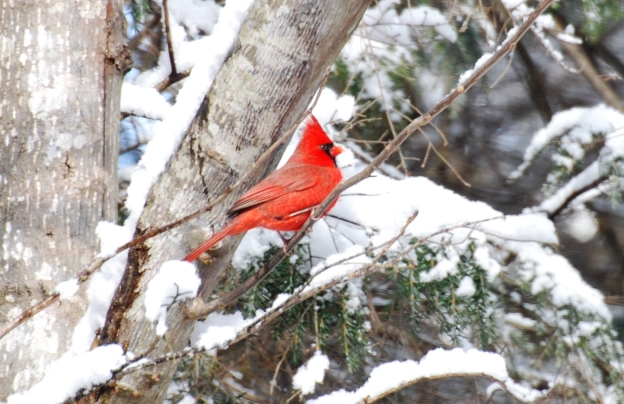I received an email recently from Dick Abrams, a resident of Bristol, Tennessee.
“We love our birds and other local critters,”
Dick wrote. “I have a question for you. Why are so many cardinals this year bald headed?”
Dick noted that some of these beloved backyard birds “are bald as buzzards!”

Many people compare cardinals afflicted with the loss of their head feathers with the look of vultures, such as this painting by John James Audubon of a California Condor.
He concluded his email by asking if anyone else had mentioned the strange phenomenon of bald cardinals.
•••••••
In addition, Gail Adler of Johnson City, Tennessee, sent me a message on Facebook on the same subject of “bald cardinals.”
“I love gardening and birdwatching,” Gail wrote in her message. “I have noticed this summer that many of my cardinals have lost the feathers on their head. Some of my other ones look a little rough, as well. I tried to look up causes but was unable to find a definite reason. Have you experienced this? Any thoughts?”
••••••••
First, I let Dick and Gail know that I’ve heard of these strange instances for many years. Bald-headed cardinals seem to be a summer occurrence. I usually get some emails or calls this time of year about people surprised by visits from “weird bald-headed” cardinals. I first began to get calls and email from readers in the late 1990s about this unusual phenomenon, although I have also seen blue jays suffering from this same ailment.
I have studied the opinions of various bird experts. Some speculate that the condition is caused by an infestation of mites, which are small relatives of spiders and other arachnids. Others believe that the loss of feathers around the head is a part of a normal molting process. This theory is supported by the fact this is the time of year when cardinals are molting.
The process of molting removes old feathers, which simply drop from the body as new feathers emerge to take their place. For some reason, some cardinals and jays lose all their head feathers at one time before new feathers are ready to take their place. That’s why the condition is typically observed in the summer months. Both male and female cardinals can be afflicted with “bald” heads. It’s strange that the condition primarily affects these two birds, cardinals and jays, both with feather crests, while cedar waxwings are also crested birds, but I have never observed or received a report on a “bald-headed” cedar waxwing.
Whatever the cause, a “bald-headed” cardinal is an ugly bird. Without feathers, a cardinal is transformed from a popular favorite among bird enthusiasts to a rather grotesque oddity. Dick got his description right when he described the bird as resembling a buzzard. Buzzards, better known as vultures, have heads bare of feathers for a very important reason. As scavengers, a feathered head would become quickly fouled as the bird reaches into the carcasses of dead animals to feed.

Photo by Bryan Stevens A male Northern Cardinal escorts a young bird to the area around a feeder to teach it to fend for itself.
Those cardinals I have seen with “bald” heads have been visiting feeders stocked with sunflower seeds or perhaps a holder offering a suet cake. So, the absence of feathers is not a hygienic adaptation on the part of cardinals and jays similar to the hygienic necessity of bald heads among vultures. The good news is that the condition lasts only a couple of weeks. The feathers on the head do emerge eventually, which is probably very fortunate for the afflicted birds. Feathers serve as insulation during cold weather. A “bald-headed” cardinal would probably not survive winter cold spells.
••••••
We’re all accustomed to seeing cardinals at our feeders. You may be surprised by how much food they obtain away from our well-stocked feeders. During the summer months, cardinals eat a variety of wild seeds, fruit and insects. Some of the fruit consumed by cardinals include elderberry, dogwood, blackberry and wild grapes. Young cardinals still in the nest (and fledglings for some time after leaving the nest) are fed mostly insects, including crickets, spiders, moths and flies.

Photo by Bryan Stevens A female Northern Cardinal perches on a log with one of young, which recently left the nest.
To make cardinals comfortable in spring, summer and fall, as well as winter, offer plenty of thick vegetation, such as a hedge or row of shrubs, and consider planting some of the fruit trees and shrubs that will help these beautiful birds supplement their diet.
••••••
Bryan Stevens lives near Roan Mountain, Tennessee. To learn more about birds and other topics from the natural world, friend Stevens on Facebook at https://www.facebook.com/ahoodedwarbler. He is always posting about local birds, wildlife, flowers, insects and much more. If you have a question, wish to make a comment or share a sighting, email ahoodedwarbler@aol.com.












